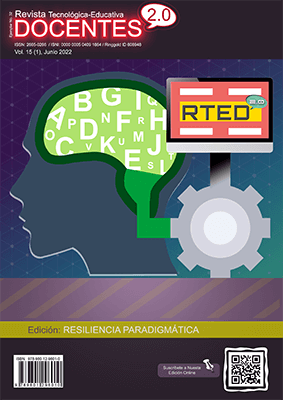The Role of Higher Education Students in Gamification according to their Motivation
 DOI:
https://doi.org/10.37843/rted.v15i1.283
DOI:
https://doi.org/10.37843/rted.v15i1.283
Main Article Content
Abstract
Gamification as a teaching-learning technique has become very popular thanks to its benefits, such as the increase in interest and motivation on the part of students in a subject. Therefore, the objective was to know the students' reasons and the games' dynamics that can be implemented to retain them in the teaching-learning process. The present investigation was carried out under the quantitative paradigm of an exploratory type, and experimental design with students enrolled in the different careers offered by the Faculty of Informatics of the Autonomous University of Querétaro. A questionnaire based on the Bartle test was applied to 49 students to find out their preferences regarding the dynamics of the games. Each student's role in the match was obtained from the instrument, the type of activities that she prefers to perform based on the dynamics of the games, and actions or factors that motivate the student. Likewise, the importance of motivation in understanding the point of view of gamification is highlighted since it is selected in different types of players or roles in the game. Every kind of player has its motivation and retention method. That must be considered when designing a virtual teaching-learning environment or gamified activity to make it successful. In conclusion, to gamify efficiently, it is essential to know our students and their motivations to retain them in the teaching process and achieve their learning.
Downloads
Metrics
Article Details

This work is licensed under a Creative Commons Attribution-NonCommercial-NoDerivatives 4.0 International License.
Those authors who have publications in our journal accept the following terms:
- When a work is accepted for publication, the author retains rights of reproduction, distribution of his/her article for exploitation in all countries of the world in the format provided by our magazine and any other magnetic medium, optical, and digital.
- Authors will retain their copyright and guarantee the journal the right first to publish their work, which will be simultaneously subject to the Creative Commons Acknowledgment License (Attribution-NonCommercial-NoDerivatives 4.0 International (CC BY-NC-ND 4.0)). That allows third parties to copy and redistribute the material in any medium or format, under the following conditions: Acknowledgment - You must properly acknowledge authorship, provide a link to the license, and indicate if any changes have been made. You may do so in any reasonable way, but not in a way that suggests you have the licensor's endorsement or receive it for your use. NonCommercial - You may not use the material for a commercial purpose. NoDerivatives - If you remix, transform, or build from the material, you cannot broadcast the modified material. There are no additional restrictions - You cannot apply legal terms or technological measures that legally restrict you from doing what the license allows.
- Authors may adopt other non-exclusive license agreements to distribute the published version of the work (e.g., deposit it in an institutional archive or publish it in a monographic volume) provided that the initial publication in this journal is indicated.
- Authors are allowed and recommended to disseminate their work through the Internet (e.g., in institutional telematic archives, repositories, libraries, or their website), producing exciting exchanges and increasing the published work's citations.
- Request of withdrawal an article has to be done in writing by the author to the Editor, becoming effective after a written response from the Editor. For this purpose, the author or authors will send correspondence via e-mail: [email protected].
- The author will not receive financial compensation for the publication of his work.
- All Docentes 2.0 Journal publications are under the Open Journal System (OJS) platform at: https://ojs.docentes20.com/.
References
Abarca, S. (1995). Psicología de la motivación. UNED.
Campanario, J. M. (2002). ¿Cómo influye la motivación en el aprendizaje de las ciencias? Revista Interuniversitaria de Formación del Profesorado, 33, 121-140.
Carrillo, M., Padilla, J., Rosero, T. & Sol-Villagómez, M. (2009). La motivación y el aprendizaje. Alteridad, 4(1), 20-33. https://www.learntechlib.org/p/195445/. DOI: https://doi.org/10.17163/alt.v4n2.2009.03
Cordero B. D., & Núñez A. M. (2018). El uso de técnicas de gamificación para estimular las competencias lingüísticas de estudiantes en un curso de ILE. Revista de Lenguas Modernas, 0(28), 269–292. https://doi.org/10.15517/rlm.v0i28.34777
Gaitán, V. (2013). Gamificación: el aprendizaje divertido. Educativa, https://www.educativa.com/blog-articulos/gamificacion-el-aprendizaje-divertido/
Hanus, M. D., & Fox, J. (2015). Assessing the effects of gamification in the classroom: A longitudinal study on intrinsic motivation, social comparison, satisfaction, effort, and academic performance. Computer & Education, 80, 152–161. https://doi.org/10.1016/j.compedu.2014.08.019 DOI: https://doi.org/10.1016/j.compedu.2014.08.019
Hueso-González, A.; Cascant I Sempere, M.J. (2012). Metodología y técnicas cuantitativas de investigación. Editorial Universitat Politècnica de València. http://hdl.handle.net/10251/17004
Losada, R. (2015). Gamificación: ¿Qué tipo de jugador eres? InnovaTalent.
Morales, B & Jéfferson, T. (2017). E-learning y gamificación como apoyo al aprendizaje de programación. http://dehesa.unex.es/handle/10662/6429
Olanco-Hernández, A. (2011). La motivación en los estudiantes universitarios. Actualidades Investigativas en Educación, 5(2). https://doi.org/10.15517/aie.v5i2.9157 DOI: https://doi.org/10.15517/aie.v5i2.9157
Oliva, H. A. (2017). La gamificación como estrategia metodológica en el contexto educativo universitario. Realidad Y Reflexión, 44, 29–47. https://doi.org/10.5377/ryr.v44i0.3563 DOI: https://doi.org/10.5377/ryr.v44i0.3563
Peñalva, S., Aguaded, I., & Torres-Toukoumidis, Á. (2018). La gamificación en la universidad española. Una perspectiva educomunicativa. Revista Mediterránea de Comunicación, 10(1), 245–256. https://doi.org/10.14198/medcom2019.10.1.6 DOI: https://doi.org/10.14198/MEDCOM2019.10.1.6
Piñeiro-Otero, T. & Costa-Sánchez, C. (2015). ARG (juegos de realidad alternativa). Contribuciones, limitaciones y potencialidades para la docencia universitaria. Comunicar, XXII. 44, 141–148. https://doi.org/10.3916/C44-2015-15 DOI: https://doi.org/10.3916/C44-2015-15
Raffini, J. (1998). 150 Maneras de incrementar la motivación en la clase. Pax México.
Salen, K., Tekinbas, K. S., & Zimmerman, E. (2004). Rules of Play: Game Design Fundamentals. MIT press. S
anmugam, M., Abdullah, Z., Mohamed, H., Aris, B., Zaid, N., & Suhadi, S. M. (2016). The affiliation between student achievement and elements of gamification in learning science. 4th International Conference on Information and Communication Technology (ICoICT). 1–4. DOI: 10.1109/ICoICT.2016.7571962 DOI: https://doi.org/10.1109/ICoICT.2016.7571962






